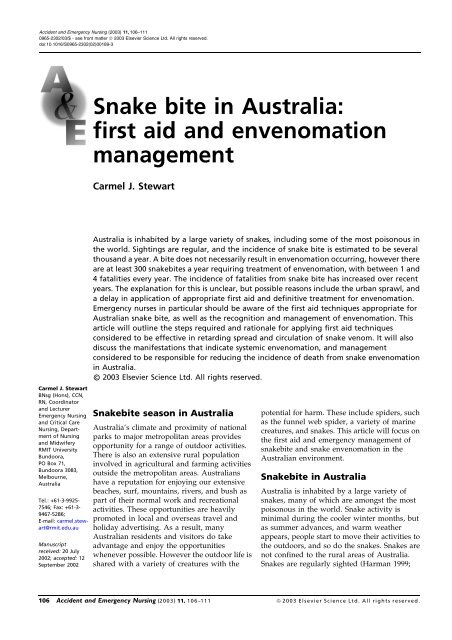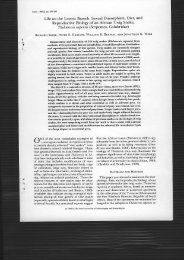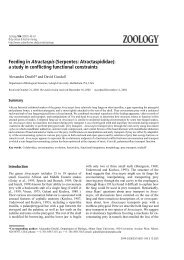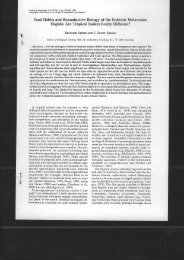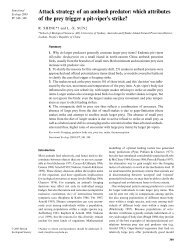Snake bite in Australia: first aid and envenomation ... - Kingsnake.com
Snake bite in Australia: first aid and envenomation ... - Kingsnake.com
Snake bite in Australia: first aid and envenomation ... - Kingsnake.com
You also want an ePaper? Increase the reach of your titles
YUMPU automatically turns print PDFs into web optimized ePapers that Google loves.
Accident <strong>and</strong> Emergency Nurs<strong>in</strong>g (2003) 11, 106–111<br />
0965-2302/03/$ - see front matter ª 2003 Elsevier Science Ltd. All rights reserved.<br />
doi:10.1016/S0965-2302(02)00189-3<br />
<strong>Snake</strong> <strong>bite</strong> <strong>in</strong> <strong>Australia</strong>:<br />
<strong>first</strong> <strong>aid</strong> <strong>and</strong> <strong>envenomation</strong><br />
management<br />
Carmel J. Stewart<br />
Carmel J. Stewart<br />
BNsg (Hons), CCN,<br />
RN, Coord<strong>in</strong>ator<br />
<strong>and</strong> Lecturer<br />
Emergency Nurs<strong>in</strong>g<br />
<strong>and</strong> Critical Care<br />
Nurs<strong>in</strong>g, Department<br />
of Nurs<strong>in</strong>g<br />
<strong>and</strong> Midwifery<br />
RMIT University<br />
Bundoora,<br />
PO Box 71,<br />
Bundoora 3083,<br />
Melbourne,<br />
<strong>Australia</strong><br />
Tel.: +61-3-9925-<br />
7546; Fax: +61-3-<br />
9467-5286;<br />
E-mail: carmel.stewart@rmit.edu.au<br />
Manuscript<br />
received: 20 July<br />
2002; accepted: 12<br />
September 2002<br />
<strong>Australia</strong> is <strong>in</strong>ha<strong>bite</strong>d by a large variety of snakes, <strong>in</strong>clud<strong>in</strong>g some of the most poisonous <strong>in</strong><br />
the world. Sight<strong>in</strong>gs are regular, <strong>and</strong> the <strong>in</strong>cidence of snake <strong>bite</strong> is estimated to be several<br />
thous<strong>and</strong> a year. A <strong>bite</strong> does not necessarily result <strong>in</strong> <strong>envenomation</strong> occurr<strong>in</strong>g, however there<br />
are at least 300 snake<strong>bite</strong>s a year requir<strong>in</strong>g treatment of <strong>envenomation</strong>, with between 1 <strong>and</strong><br />
4 fatalities every year. The <strong>in</strong>cidence of fatalities from snake <strong>bite</strong> has <strong>in</strong>creased over recent<br />
years. The explanation for this is unclear, but possible reasons <strong>in</strong>clude the urban sprawl, <strong>and</strong><br />
a delay <strong>in</strong> application of appropriate <strong>first</strong> <strong>aid</strong> <strong>and</strong> def<strong>in</strong>itive treatment for <strong>envenomation</strong>.<br />
Emergency nurses <strong>in</strong> particular should be aware of the <strong>first</strong> <strong>aid</strong> techniques appropriate for<br />
<strong>Australia</strong>n snake <strong>bite</strong>, as well as the recognition <strong>and</strong> management of <strong>envenomation</strong>. This<br />
article will outl<strong>in</strong>e the steps required <strong>and</strong> rationale for apply<strong>in</strong>g <strong>first</strong> <strong>aid</strong> techniques<br />
considered to be effective <strong>in</strong> retard<strong>in</strong>g spread <strong>and</strong> circulation of snake venom. It will also<br />
discuss the manifestations that <strong>in</strong>dicate systemic <strong>envenomation</strong>, <strong>and</strong> management<br />
considered to be responsible for reduc<strong>in</strong>g the <strong>in</strong>cidence of death from snake <strong>envenomation</strong><br />
<strong>in</strong> <strong>Australia</strong>.<br />
c 2003 Elsevier Science Ltd. All rights reserved.<br />
<strong>Snake</strong><strong>bite</strong> season <strong>in</strong> <strong>Australia</strong><br />
<strong>Australia</strong>’s climate <strong>and</strong> proximity of national<br />
parks to major metropolitan areas provides<br />
opportunity for a range of outdoor activities.<br />
There is also an extensive rural population<br />
<strong>in</strong>volved <strong>in</strong> agricultural <strong>and</strong> farm<strong>in</strong>g activities<br />
outside the metropolitan areas. <strong>Australia</strong>ns<br />
have a reputation for enjoy<strong>in</strong>g our extensive<br />
beaches, surf, mounta<strong>in</strong>s, rivers, <strong>and</strong> bush as<br />
part of their normal work <strong>and</strong> recreational<br />
activities. These opportunities are heavily<br />
promoted <strong>in</strong> local <strong>and</strong> overseas travel <strong>and</strong><br />
holiday advertis<strong>in</strong>g. As a result, many<br />
<strong>Australia</strong>n residents <strong>and</strong> visitors do take<br />
advantage <strong>and</strong> enjoy the opportunities<br />
whenever possible. However the outdoor life is<br />
shared with a variety of creatures with the<br />
potential for harm. These <strong>in</strong>clude spiders, such<br />
as the funnel web spider, a variety of mar<strong>in</strong>e<br />
creatures, <strong>and</strong> snakes. This article will focus on<br />
the <strong>first</strong> <strong>aid</strong> <strong>and</strong> emergency management of<br />
snake<strong>bite</strong> <strong>and</strong> snake <strong>envenomation</strong> <strong>in</strong> the<br />
<strong>Australia</strong>n environment.<br />
<strong>Snake</strong><strong>bite</strong> <strong>in</strong> <strong>Australia</strong><br />
<strong>Australia</strong> is <strong>in</strong>ha<strong>bite</strong>d by a large variety of<br />
snakes, many of which are amongst the most<br />
poisonous <strong>in</strong> the world. <strong>Snake</strong> activity is<br />
m<strong>in</strong>imal dur<strong>in</strong>g the cooler w<strong>in</strong>ter months, but<br />
as summer advances, <strong>and</strong> warm weather<br />
appears, people start to move their activities to<br />
the outdoors, <strong>and</strong> so do the snakes. <strong>Snake</strong>s are<br />
not conf<strong>in</strong>ed to the rural areas of <strong>Australia</strong>.<br />
<strong>Snake</strong>s are regularly sighted (Harman 1999;<br />
106 Accident <strong>and</strong> Emergency Nurs<strong>in</strong>g (2003) 11, 106–111 ª 2003 Elsevier Science Ltd. All rights reserved.
<strong>Snake</strong> <strong>bite</strong> <strong>in</strong> <strong>Australia</strong><br />
Sprivulis & Jel<strong>in</strong>ek 2000), <strong>and</strong> residents <strong>and</strong><br />
visitors of metropolitan areas may experience<br />
snake <strong>bite</strong> <strong>and</strong> possible <strong>envenomation</strong>. In<br />
recent years, the <strong>in</strong>cidence of snake <strong>bite</strong>s <strong>and</strong><br />
fatalities from snake <strong>bite</strong>s have <strong>in</strong>creased<br />
(AVRU 2000). The explanation for this is<br />
unclear, but may be due to the urban sprawl,<br />
<strong>and</strong> a delay <strong>in</strong> application of appropriate <strong>first</strong><br />
<strong>aid</strong> <strong>and</strong> def<strong>in</strong>itive treatment (Sprivulis &<br />
Jel<strong>in</strong>ek 2000). The actual <strong>in</strong>cidence of snake<strong>bite</strong><br />
<strong>in</strong> <strong>Australia</strong> is estimated to be several<br />
thous<strong>and</strong>s each year, with approximately 300<br />
recorded cases requir<strong>in</strong>g antivenom<br />
adm<strong>in</strong>istration (AVRU 2000). The <strong>in</strong>cidence of<br />
deaths from snake<strong>bite</strong> is estimated to be<br />
between 1 <strong>and</strong> 4 a year (AVRU 2000; Sprivulis<br />
& Jel<strong>in</strong>ek 2000; White 1998). The <strong>in</strong>accuracy of<br />
<strong>in</strong>formation related to the <strong>in</strong>cidence of<br />
snake<strong>bite</strong> <strong>and</strong> death from <strong>envenomation</strong> is<br />
attributed to the possibility of unrecognised<br />
snake<strong>bite</strong> <strong>and</strong> <strong>envenomation</strong> (AVRU 2000). For<br />
this reason, emergency nurses should consider<br />
any patient present<strong>in</strong>g with a suspected<br />
snake<strong>bite</strong> as hav<strong>in</strong>g been bitten by a snake until<br />
proven otherwise. The potential for snake<strong>bite</strong><br />
exists <strong>in</strong> metropolitan, regional, <strong>and</strong> rural<br />
areas, <strong>and</strong> hence emergency nurses <strong>in</strong> all areas<br />
need to have a heightened awareness of the<br />
possibility, <strong>and</strong> to be aware of <strong>first</strong> <strong>aid</strong> <strong>and</strong><br />
<strong>envenomation</strong> recognition <strong>and</strong> management.<br />
<strong>Australia</strong>n snakes <strong>and</strong> their<br />
venom<br />
There are over 140 recognised snakes <strong>in</strong><br />
<strong>Australia</strong> (Shea 1999). Not all of these are<br />
venomous, <strong>and</strong> those that are (<strong>and</strong> represent<br />
those that are known to have caused<br />
<strong>envenomation</strong> <strong>in</strong> the human population) may<br />
be grouped <strong>in</strong>to six ma<strong>in</strong> groups of brown<br />
snake, tiger snake, copperhead, black snake,<br />
taipan, <strong>and</strong> death adder (Shea 1999; White<br />
1998). These large varieties of snakes <strong>in</strong>habit<br />
known geographical areas. For example, the<br />
taipan is a highly venomous <strong>and</strong> aggressive<br />
snake that <strong>in</strong>habits the northern parts of<br />
<strong>Australia</strong>, <strong>and</strong> will not naturally be found <strong>in</strong><br />
the southern regions, <strong>and</strong> the death adder can<br />
be found <strong>in</strong> all regions except Victoria <strong>and</strong><br />
Tasmania (AVRU 2000; Shea 1999). The<br />
copperhead is a cool climate snake, <strong>and</strong><br />
<strong>in</strong>habits the southern states of <strong>Australia</strong>,<br />
<strong>in</strong>clud<strong>in</strong>g Tasmania, as are tiger snakes (AVRU<br />
2000; Shea 1999). There have been record<strong>in</strong>gs of<br />
tiger snakes <strong>in</strong> small numbers <strong>in</strong> parts of<br />
warmer Queensl<strong>and</strong>, however they are more<br />
<strong>com</strong>mon <strong>in</strong> Tasmania <strong>and</strong> other southern areas<br />
(Shea 1999). Knowledge of the usual<br />
geographical habitat for particular snakes is<br />
useful <strong>in</strong> that it can assist <strong>in</strong> identify<strong>in</strong>g the<br />
snake <strong>in</strong>volved <strong>in</strong> a <strong>bite</strong> <strong>and</strong> <strong>envenomation</strong>.<br />
The major effects of <strong>Australia</strong>n snake venom<br />
<strong>in</strong>clude neurotox<strong>in</strong>s that result <strong>in</strong> a general<br />
paralys<strong>in</strong>g effect, coagulation abnormalities of<br />
<strong>in</strong>creased clott<strong>in</strong>g <strong>and</strong> anticoagulation, myolitic<br />
activity result<strong>in</strong>g <strong>in</strong> muscle breakdown <strong>and</strong><br />
subsequent renal failure, <strong>and</strong> a direct<br />
nephrotoxic effect (AVRU 2000; Sprivulis &<br />
Jel<strong>in</strong>ek 2000; White 1998). A local cytotoxic<br />
effect may occur at the <strong>bite</strong> site, however this is<br />
not a major effect of <strong>Australia</strong>n snake venom<br />
(AVRU 2000; Sprivulis & Jel<strong>in</strong>ek 2000; White<br />
1998).<br />
The various snakes may exhibit only one or<br />
two of these effects, <strong>and</strong> to vary<strong>in</strong>g degrees.<br />
For example, the brown snake venom is<br />
attributed to hav<strong>in</strong>g a direct nephrotoxic effect,<br />
while the venom of the tiger <strong>and</strong> taipan may<br />
cause renal failure secondary to<br />
rhabdomyolysis from the myolitic effect of<br />
their venom (Sprivulis & Jel<strong>in</strong>ek 2000).<br />
Consumptive coagulopathies have been<br />
attributed to the venom of taipan, brown, tiger<br />
snakes (Sprivulis & Jel<strong>in</strong>ek 2000; White 1998)<br />
<strong>and</strong> the black snake (White 1998). Note that<br />
<strong>in</strong>dividual snake species do not exert only one<br />
toxic effect. Several have <strong>com</strong>ponents of<br />
neurotox<strong>in</strong>s, haemotox<strong>in</strong> (<strong>in</strong>clud<strong>in</strong>g anti- <strong>and</strong><br />
procoagulant effects), myotox<strong>in</strong> <strong>and</strong><br />
nephrotox<strong>in</strong> effects, although they vary <strong>in</strong><br />
potency from one snake to another. For<br />
example the taipan has potent neurotoxic <strong>and</strong><br />
hence paralys<strong>in</strong>g effects, with only weak<br />
haemotoxic <strong>and</strong> coagulant effects<br />
(Evans-Murray & Foster 1996). The brown<br />
snake has been attributed to hav<strong>in</strong>g highly<br />
potent coagulant effects requir<strong>in</strong>g a<br />
significant <strong>in</strong>crease <strong>in</strong> the amount of<br />
antivenom required to reverse the effects<br />
(AVRU 2000; Sprivulis & Jel<strong>in</strong>ek 2000).<br />
As all snakes with<strong>in</strong> a group conta<strong>in</strong> similar<br />
tox<strong>in</strong>s <strong>in</strong> their venoms, it has been possible to<br />
develop specific antivenoms. The reduction <strong>in</strong><br />
death due to snake <strong>bite</strong> s<strong>in</strong>ce the beg<strong>in</strong>n<strong>in</strong>g of<br />
ª 2003 Elsevier Science Ltd. All rights reserved. Accident <strong>and</strong> Emergency Nurs<strong>in</strong>g (2003) 11, 106–111 107
<strong>Snake</strong> <strong>bite</strong> <strong>in</strong> <strong>Australia</strong><br />
the 20th century is attributed <strong>in</strong> part to the<br />
development of these antivenoms (Sprivulis &<br />
Jel<strong>in</strong>ek 2000). However, <strong>Australia</strong>n snake<br />
venom may exert its effects rapidly (White<br />
1998), <strong>and</strong> limit<strong>in</strong>g the spread of the venom<br />
away from the <strong>bite</strong> site is also an important<br />
aspect <strong>in</strong> the reduction of morbidity <strong>and</strong><br />
mortality due to snake <strong>envenomation</strong> (AVRU<br />
2000; Sprivulis & Jel<strong>in</strong>ek 2000).<br />
First <strong>aid</strong><br />
First <strong>aid</strong> techniques have been credited with<br />
reduc<strong>in</strong>g the fatalities associated with<br />
snake<strong>bite</strong> <strong>in</strong> <strong>Australia</strong> (AVRU 2000; Sprivulis &<br />
Jel<strong>in</strong>ek 2000). <strong>Snake</strong> venom is circulated<br />
through the body via the lymphatic system,<br />
<strong>and</strong> the pressure-immobilisation-b<strong>and</strong>age or<br />
PIM B<strong>and</strong>age is effective <strong>in</strong> reduc<strong>in</strong>g systemic<br />
<strong>envenomation</strong> (Sprivulis & Jel<strong>in</strong>ek 2000). This<br />
is a technique that should optimally be<br />
employed at the time <strong>and</strong> scene of the<br />
snake<strong>bite</strong>. However, this is not always the<br />
case, <strong>and</strong> victims of <strong>bite</strong>s may present for<br />
treatment of snake<strong>bite</strong> with no <strong>first</strong> <strong>aid</strong> for a<br />
variety of reasons, that anecdotal <strong>in</strong>formation<br />
<strong>in</strong>dicates <strong>in</strong>cludes panic, <strong>and</strong> lack of<br />
knowledge of <strong>first</strong> <strong>aid</strong> techniques. As part of<br />
the management of snake<strong>bite</strong>, <strong>first</strong> <strong>aid</strong><br />
<strong>in</strong>terventions should be applied as early as<br />
possible, <strong>in</strong>clud<strong>in</strong>g on presentation to the<br />
emergency department (Sprivulis & Jel<strong>in</strong>ek<br />
2000). Hence application of the PIM b<strong>and</strong>age is<br />
a priority <strong>in</strong> the triage <strong>in</strong>tervention of a<br />
possible snake <strong>bite</strong> victim.<br />
Further highlight<strong>in</strong>g the need for application<br />
of the PIM b<strong>and</strong>age immediately on<br />
presentation to the emergency department is<br />
the considerable time that is required to assess<br />
the victim, identify that <strong>envenomation</strong> has<br />
occurred <strong>and</strong> the type of snake <strong>in</strong>volved, <strong>and</strong><br />
organise <strong>and</strong> adm<strong>in</strong>ister antivenom. The time<br />
required to achieve these aims, <strong>and</strong> any<br />
<strong>in</strong>terven<strong>in</strong>g delays, <strong>in</strong>creases the possibility of<br />
systemic distribution of the venom. For<br />
example, the most reliable way to identify the<br />
type of snake <strong>in</strong>volved, <strong>and</strong> hence adm<strong>in</strong>ister<br />
the most appropriate antivenom is through<br />
us<strong>in</strong>g the venom detection kit. This however<br />
takes 25 m<strong>in</strong> to obta<strong>in</strong> a result (White 1998).<br />
Further explanation for the need to apply a<br />
PIM b<strong>and</strong>age on arrival <strong>in</strong> the emergency<br />
department will be discussed with the<br />
adm<strong>in</strong>istration of antivenom.<br />
The PIM b<strong>and</strong>age <strong>in</strong>cludes the application of<br />
a spl<strong>in</strong>t to reduce movement of the limb where<br />
the <strong>bite</strong> has been <strong>in</strong>flicted. In addition to this, it<br />
is highlighted that immobilis<strong>in</strong>g the patient is<br />
an important measure to reduce the spread of<br />
the venom (AVRU 2000; Sprivulis & Jel<strong>in</strong>ek<br />
2000). This means that under all circumstances,<br />
transport (<strong>in</strong>clud<strong>in</strong>g wheelchairs or trolleys)<br />
are bought to the patient, rather than hav<strong>in</strong>g<br />
the patient walk. It is also important not to<br />
wash the site, as venom at the <strong>bite</strong> site is used<br />
to assist <strong>in</strong> snake identification.<br />
Application of the pressureimmobilisation<br />
b<strong>and</strong>age<br />
The PIM b<strong>and</strong>age aims to <strong>com</strong>press tissues<br />
surround<strong>in</strong>g the <strong>bite</strong>, <strong>and</strong> hence slow<br />
lymphatic circulation of the venom. The PIM<br />
b<strong>and</strong>age is designed for snake<strong>bite</strong>s to the<br />
limbs, as these are the most <strong>com</strong>mon sites<br />
(AVRU 2000). Local pressure should be applied<br />
to <strong>bite</strong>s to the head, neck, <strong>and</strong> torso (AVRU<br />
2000). Sprivulis <strong>and</strong> Jel<strong>in</strong>ek (2000) suggest the<br />
use of adrenal<strong>in</strong>e <strong>in</strong>jected <strong>in</strong>to the site to retard<br />
the spread of venom.<br />
The follow<strong>in</strong>g technique of adm<strong>in</strong>istration of<br />
the PIM b<strong>and</strong>age was orig<strong>in</strong>ally developed by<br />
Struan Sutherl<strong>and</strong>, <strong>and</strong> has been re<strong>com</strong>mended<br />
as <strong>first</strong> <strong>aid</strong> for snake <strong>bite</strong> s<strong>in</strong>ce 1979 (Sutherl<strong>and</strong><br />
1981).<br />
1. Identify the site of the <strong>bite</strong> from the victims’<br />
subjective account. It is not always possible<br />
to identify fang marks. The absence of any<br />
mark does not exclude the possibility of<br />
snake<strong>bite</strong>–suspicion must rema<strong>in</strong> high.<br />
2. From the <strong>bite</strong> site apply a <strong>com</strong>pression<br />
b<strong>and</strong>age to the digits (leav<strong>in</strong>g tips exposed<br />
to allow for monitor<strong>in</strong>g of circulation), <strong>and</strong><br />
then back to the top of the limb. This is<br />
appropriate if the patient is only a short time<br />
from def<strong>in</strong>itive treatment. If the patient has<br />
yet to be transported considerable distance,<br />
the b<strong>and</strong>age will be better tolerated if<br />
applied from the digits upwards (AVRU<br />
2000). Although this carries a risk of push<strong>in</strong>g<br />
venom away from the site, the risk is<br />
considered m<strong>in</strong>imal (AVRU 2000). Crepe<br />
b<strong>and</strong>ages are <strong>com</strong>monly available <strong>and</strong><br />
108 Accident <strong>and</strong> Emergency Nurs<strong>in</strong>g (2003) 11, 106–111 ª 2003 Elsevier Science Ltd. All rights reserved.
<strong>Snake</strong> <strong>bite</strong> <strong>in</strong> <strong>Australia</strong><br />
suitable for apply<strong>in</strong>g adequate <strong>com</strong>pression.<br />
The b<strong>and</strong>age is not to act as a tourniquet,<br />
<strong>and</strong> should be applied to a firmness<br />
appropriate for a spra<strong>in</strong>ed ankle, <strong>and</strong> should<br />
be selected with the size of the limb taken<br />
<strong>in</strong>to consideration, for example a 10 cm<br />
b<strong>and</strong>age is appropriate for the lower limb of<br />
an adult.<br />
3. Do not wash or clean the site prior to<br />
application, as this will remove traces of<br />
venom required for snake <strong>and</strong> antivenom<br />
identification. A small w<strong>in</strong>dow can be cut <strong>in</strong><br />
the b<strong>and</strong>age at the <strong>bite</strong> site to take a venom<br />
swab. A mark on the outside of the b<strong>and</strong>age,<br />
placed at the time of application, can assist<br />
<strong>in</strong> identify<strong>in</strong>g the appropriate site for the<br />
w<strong>in</strong>dow.<br />
4. A spl<strong>in</strong>t should be applied to keep the limb<br />
immobilised, <strong>and</strong> the patient placed <strong>in</strong> a<br />
position of rest.<br />
5. This b<strong>and</strong>age should rema<strong>in</strong> <strong>in</strong> place until<br />
the possibility of <strong>envenomation</strong> has been<br />
excluded, or an <strong>in</strong>fusion of antivenom has<br />
been <strong>com</strong>menced<br />
Identify<strong>in</strong>g the snake <strong>in</strong>volved<br />
It is necessary to identify if a snake<strong>bite</strong> has<br />
occurred, <strong>and</strong> as a separate responsibility,<br />
identify if <strong>envenomation</strong> of the victim has<br />
occurred. Fang marks are not always left after a<br />
snake has bitten. There may be a scratch, or it<br />
may not be possible to identify any marks at all<br />
(AVRU 2000). In this case it is necessary to rely<br />
on the patients description of where the <strong>bite</strong><br />
occurred. It is important to realise that this<br />
does not exclude the possibility of snake<strong>bite</strong>,<br />
<strong>and</strong> assessment <strong>and</strong> management of<br />
<strong>envenomation</strong> needs to cont<strong>in</strong>ue.<br />
Even if a snake does <strong>bite</strong>, it does not always<br />
<strong>in</strong>ject venom, adequate venom to cause<br />
<strong>envenomation</strong>, or <strong>in</strong>ject venom <strong>in</strong>to the tissues<br />
(AVRU 2000). A Venom Detection Kit (VDK),<br />
developed by the Commonwealth Serum<br />
Laboratories under the guidance of the late<br />
Struan Sutherl<strong>and</strong>, is used to identify the type<br />
of snake, <strong>and</strong> the antivenom to be used <strong>in</strong> the<br />
case of <strong>envenomation</strong>. This test is considered<br />
highly reliable (White 1998). The VDK is more<br />
reliable than visual identification of the snake,<br />
as snake appearance alters with seasonal<br />
changes. Much identification is based on scale<br />
shape <strong>and</strong> size rather than overall colour <strong>and</strong><br />
mark<strong>in</strong>gs <strong>and</strong> requires an experienced<br />
herpetologist to dist<strong>in</strong>guish one type of snake<br />
from another (AVRU 2000). Visual<br />
identification of the snake often requires the<br />
snake to be killed, <strong>and</strong> this practice <strong>in</strong>creases<br />
the danger <strong>and</strong> probability of snake <strong>bite</strong>,<br />
angers the snake <strong>and</strong> <strong>in</strong>creases the danger of<br />
<strong>envenomation</strong>, <strong>and</strong> is an illegal act as snakes <strong>in</strong><br />
<strong>Australia</strong> are a protected species under the<br />
Nature Conservation Act 1980 (Environment<br />
ACT 2000).<br />
Swabs of the site, <strong>and</strong> if systemic symptoms<br />
are present, ur<strong>in</strong>e, is <strong>com</strong>b<strong>in</strong>ed with the<br />
solutions <strong>and</strong> vials as directed by written<br />
<strong>in</strong>structions supplied with the VDK. The<br />
results will <strong>in</strong>form cl<strong>in</strong>icians of the type of<br />
antivenom that will be effective. Blood is not<br />
re<strong>com</strong>mended for use <strong>in</strong> the VDK as it can give<br />
mislead<strong>in</strong>g results <strong>in</strong> the form of false positives<br />
<strong>and</strong> false negatives (Sprivulis & Jel<strong>in</strong>ek 2000;<br />
White 1998).<br />
Identify<strong>in</strong>g <strong>envenomation</strong><br />
If venom has been identified through the VDK,<br />
it is then necessary to determ<strong>in</strong>e if the patient<br />
has been envenomated. Many patients,<br />
although certa<strong>in</strong>ly bitten by a snake do not<br />
experience <strong>envenomation</strong> (Sprivulis & Jel<strong>in</strong>ek<br />
2000). This will possibly have already been<br />
determ<strong>in</strong>ed by the frequent assessment that<br />
will have been cont<strong>in</strong>u<strong>in</strong>g throughout the<br />
venom identification process. Victims should<br />
be observed for signs of paralysis or<br />
paraesthesia, such as blurred vision, slurred<br />
speech. These are symptoms associated<br />
with the neurotox<strong>in</strong>s found <strong>in</strong> many of<br />
<strong>Australia</strong>’s snakes, but may also be due to<br />
myotox<strong>in</strong> activity (White 1998). Other tests<br />
<strong>in</strong>clude a full blood exam<strong>in</strong>ation <strong>and</strong> clott<strong>in</strong>g<br />
profile to identify abnormalities associated<br />
with haemotox<strong>in</strong>s. Physical assessment may<br />
reveal bruis<strong>in</strong>g or ooz<strong>in</strong>g of blood from<br />
small wounds or mucous membranes (White<br />
1998). Urea, creat<strong>in</strong><strong>in</strong>e, electrolytes, <strong>and</strong><br />
creat<strong>in</strong><strong>in</strong>e k<strong>in</strong>ase should also be evaluated<br />
for signs of effects of tox<strong>in</strong>s on renal function<br />
<strong>and</strong> muscle breakdown. Any variation from<br />
normal identified <strong>in</strong> frequent assessments<br />
should be considered as a sign of<br />
<strong>envenomation</strong>.<br />
ª 2003 Elsevier Science Ltd. All rights reserved. Accident <strong>and</strong> Emergency Nurs<strong>in</strong>g (2003) 11, 106–111 109
<strong>Snake</strong> <strong>bite</strong> <strong>in</strong> <strong>Australia</strong><br />
Patients may also experience nausea,<br />
vomit<strong>in</strong>g, abdom<strong>in</strong>al pa<strong>in</strong>, headache,<br />
dizz<strong>in</strong>ess, or sweat<strong>in</strong>g. However <strong>in</strong> the absence<br />
of signs of paralysis or laboratory data, these<br />
manifestations cannot be considered as<br />
<strong>in</strong>dications of <strong>envenomation</strong> (Sprivulis &<br />
Jel<strong>in</strong>ek 2000).<br />
Adm<strong>in</strong>ister<strong>in</strong>g antivenom<br />
Once systemic signs of <strong>envenomation</strong> have<br />
been identified, the patient is adm<strong>in</strong>istered<br />
antivenom as an antidote. The antivenom of<br />
choice is <strong>in</strong>dicated by the VDK, <strong>and</strong> supplies of<br />
appropriate antivenom should be ma<strong>in</strong>ta<strong>in</strong>ed<br />
<strong>in</strong> hospitals with<strong>in</strong> the known geographic<br />
snake habitats. These patients should be<br />
managed <strong>in</strong> an area fully equipped with<br />
resuscitative equipment.<br />
In some cases there may be <strong>in</strong>adequate<br />
venom swabbed from the site, or the venom<br />
may not have been excreted <strong>in</strong>to the ur<strong>in</strong>e to<br />
allow the VDK to identify the snake <strong>in</strong>volved,<br />
but signs of <strong>envenomation</strong> are identified. In<br />
other cases, systemic <strong>envenomation</strong> may be<br />
obvious <strong>and</strong> severe, <strong>and</strong> hence it is<br />
<strong>in</strong>appropriate to delay adm<strong>in</strong>istration of<br />
antivenom (White 1998). In these cases,<br />
because of the known habitat regions, <strong>and</strong><br />
similarities of tox<strong>in</strong>s with<strong>in</strong> the venom,<br />
guidel<strong>in</strong>es exist for the type of antivenom to be<br />
adm<strong>in</strong>istered.<br />
The <strong>Australia</strong>n Venom Research Unit<br />
re<strong>com</strong>mends: <strong>in</strong> Tasmania, adm<strong>in</strong>istration of<br />
tiger snake antivenom; <strong>in</strong> Victoria,<br />
adm<strong>in</strong>istration of tiger snake <strong>and</strong> brown snake<br />
antivenom; <strong>in</strong> all other areas, polyvalent<br />
antivenom is required to cover the range of<br />
snakes that may have <strong>in</strong>flicted the <strong>bite</strong> (AVRU<br />
2000).<br />
The antivenom is adm<strong>in</strong>istered <strong>in</strong> a diluted<br />
form via <strong>in</strong>fusion. Adm<strong>in</strong>istration of the<br />
antivenom is clearly outl<strong>in</strong>ed <strong>in</strong> the product<br />
<strong>in</strong>formation <strong>in</strong>sert. These should be carefully<br />
read <strong>and</strong> adhered to. Allergic reaction,<br />
<strong>in</strong>clud<strong>in</strong>g anaphylaxis, to the antivenom is<br />
possible as it is produced from horse serum,<br />
however this is reported as be<strong>in</strong>g a rare<br />
occurrence (AVRU 2000; Sprivulis & Jel<strong>in</strong>ek<br />
2000). To counteract this, the <strong>in</strong>fusion should<br />
be <strong>com</strong>menced slowly, <strong>and</strong> can be <strong>in</strong>creased to<br />
the required rate if the patient displays no<br />
signs of allergic response (AVRU 2000). Other<br />
measures to prevent an allergic response are<br />
the adm<strong>in</strong>istration of prophylactic adrenal<strong>in</strong>e<br />
<strong>and</strong> promethaz<strong>in</strong>e (Sprivulis & Jel<strong>in</strong>ek 2000).<br />
These measures are controversial as it is<br />
considered the adverse effects outweigh the<br />
potential beneficial effects, <strong>and</strong> there have been<br />
reports of allergic reactions occurr<strong>in</strong>g despite<br />
these measures (White 1998). As a result of this<br />
controversy, adm<strong>in</strong>istration of prophylactic<br />
medications is left to <strong>in</strong>dividual physician<br />
discretion. White (1998) reports that a survey<br />
revealed that prophylaxis for allergic responses<br />
is rarely used.<br />
The PIM b<strong>and</strong>age should not be removed<br />
until the <strong>in</strong>fusion has <strong>com</strong>menced to prevent<br />
worsen<strong>in</strong>g of systemic symptoms, <strong>and</strong> possible<br />
worsen<strong>in</strong>g of the victims’ cl<strong>in</strong>ical state. For the<br />
antivenom to be effective, it needs to <strong>com</strong>e <strong>in</strong><br />
contact with the circulat<strong>in</strong>g venom. Therefore,<br />
once the antivenom <strong>in</strong>fusion has been<br />
<strong>com</strong>menced, the b<strong>and</strong>age can be removed. At<br />
this time the patient requires close <strong>and</strong><br />
observant monitor<strong>in</strong>g as the release of venom<br />
may overwhelm the <strong>in</strong>fused antivenom. Any<br />
deterioration <strong>in</strong> the victims’ condition may be<br />
an <strong>in</strong>dication of worsen<strong>in</strong>g <strong>envenomation</strong>, <strong>and</strong><br />
replacement of the PIM b<strong>and</strong>age should be<br />
undertaken. This will slow any further release,<br />
<strong>and</strong> allow the antivenom to act aga<strong>in</strong>st the<br />
circulat<strong>in</strong>g venom. Improvement <strong>and</strong><br />
stabilisation of the victims’ condition <strong>in</strong>dicates<br />
that the PIM b<strong>and</strong>age can aga<strong>in</strong> be released.<br />
This process is cont<strong>in</strong>ued until the PIM<br />
b<strong>and</strong>age has been <strong>com</strong>pletely removed, <strong>and</strong><br />
the patient rema<strong>in</strong>s stable, <strong>and</strong> signs of<br />
<strong>envenomation</strong> improve. Transfer to the<br />
<strong>in</strong>tensive care unit is then appropriate for<br />
any patient who has displayed signs of<br />
<strong>envenomation</strong>, if this has not already occurred.<br />
It should be noted, that there is no limit to<br />
the amount of antivenom required. This is<br />
guided by the victims’ cl<strong>in</strong>ical condition, <strong>and</strong><br />
there is no maximum or limit to the dose for<br />
either adults or children.<br />
Absence of <strong>envenomation</strong><br />
Very few patients will experience<br />
<strong>envenomation</strong> despite receiv<strong>in</strong>g a snake<strong>bite</strong>. In<br />
these patients appropriate treatment <strong>in</strong>volves<br />
removal of the PIM b<strong>and</strong>age under close<br />
110 Accident <strong>and</strong> Emergency Nurs<strong>in</strong>g (2003) 11, 106–111 ª 2003 Elsevier Science Ltd. All rights reserved.
<strong>Snake</strong> <strong>bite</strong> <strong>in</strong> <strong>Australia</strong><br />
observation <strong>in</strong> an area fully equipped with<br />
resuscitative equipment. Repeat blood tests<br />
should be taken <strong>and</strong> evaluated one hour after<br />
removal of the b<strong>and</strong>age. If there is no change <strong>in</strong><br />
the patients condition or laboratory reports, the<br />
patient may be moved to an observation area<br />
for close monitor<strong>in</strong>g <strong>and</strong> repeat blood tests at 6<br />
<strong>and</strong> 12 h (Sprivulis & Jel<strong>in</strong>ek 2000). In the<br />
absence of <strong>in</strong>dications of <strong>envenomation</strong> over<br />
the 12 h period, it is suitable to discharge the<br />
well patient to home.<br />
Conclusion<br />
<strong>Snake</strong><strong>bite</strong> rema<strong>in</strong>s a prevalent hazard <strong>in</strong> the<br />
<strong>Australia</strong>n environment, although<br />
<strong>envenomation</strong> from snake <strong>bite</strong> has a relatively<br />
low <strong>in</strong>cidence. Despite this, there has been a<br />
concern<strong>in</strong>g <strong>in</strong>crease <strong>in</strong> death from snake <strong>bite</strong> <strong>in</strong><br />
recent years. This has been attributed to the<br />
<strong>in</strong>appropriate <strong>first</strong> <strong>aid</strong> management <strong>and</strong> lack of<br />
recognition of snake <strong>bite</strong> <strong>and</strong> <strong>envenomation</strong>.<br />
Emergency nurses need to be aware of the<br />
possibility of patients present<strong>in</strong>g with<br />
snake<strong>bite</strong>, the <strong>first</strong> <strong>aid</strong> measures required to<br />
m<strong>in</strong>imise systemic <strong>envenomation</strong>, <strong>and</strong> the<br />
assessment <strong>and</strong> treatment required for these<br />
patients.<br />
A guid<strong>in</strong>g pr<strong>in</strong>ciple <strong>in</strong> the <strong>in</strong>itial<br />
management of snake<strong>bite</strong> is to assume there<br />
has been a snake<strong>bite</strong> <strong>and</strong> <strong>envenomation</strong> until<br />
proven otherwise. Venom detection kits <strong>and</strong><br />
awareness of cl<strong>in</strong>ical manifestations of<br />
<strong>envenomation</strong> will guide the appropriate<br />
adm<strong>in</strong>istration of antivenom to counteract the<br />
effects of <strong>Australia</strong>n snake venom.<br />
References<br />
AVRU, 2000. <strong>Australia</strong>n Venom Research Unit. University<br />
of Melbourne http://www.pharmacology.unimelb.<br />
edu.au/pharmwww/avruweb/<strong>in</strong>dex.htm <strong>Snake</strong><strong>bite</strong><br />
<strong>in</strong> <strong>Australia</strong> last updated 14/12/2000. (accessed 11th<br />
July 11, 2002)<br />
Environment ACT, 2000. http://www.environment.<br />
act.gov. au/ie4/pets<strong>and</strong>localwildlife/liv<strong>in</strong>gwithsnakes.<br />
html accessed 11th July 2002)<br />
Evans-Murray A, Foster M 1996 <strong>Snake</strong> <strong>bite</strong> – an<br />
occupational hazard. <strong>Australia</strong>n Critical Care 9(3):<br />
88–91<br />
Harman A 1999 Confront<strong>in</strong>g deadly <strong>bite</strong>rs. Law <strong>and</strong> Order<br />
October: 88–90<br />
Shea GM 1999 The distribution <strong>and</strong> identification of<br />
dangerously venomous <strong>Australia</strong>n terrestrial snakes.<br />
<strong>Australia</strong>n Veter<strong>in</strong>arian Journal 77(12): 791–798<br />
Sprivulis P, Jel<strong>in</strong>ek G 2000 Toxicology – <strong>Snake</strong><strong>bite</strong>. In:<br />
Cameron et al., (eds). Textbook of Adult Emergency<br />
Medic<strong>in</strong>e. Churchill Liv<strong>in</strong>gstone, Ed<strong>in</strong>burgh<br />
pp. 649–652<br />
Sutherl<strong>and</strong> S 1981 In: Venomous Creatures <strong>in</strong> <strong>Australia</strong>.<br />
Oxford University Press, Melbourne pp. 8–9<br />
White J 1998 Envenom<strong>in</strong>g <strong>and</strong> antivenom use <strong>in</strong> <strong>Australia</strong>.<br />
Toxicon 36(11): 1483–1492<br />
ª 2003 Elsevier Science Ltd. All rights reserved. Accident <strong>and</strong> Emergency Nurs<strong>in</strong>g (2003) 11, 106–111 111


